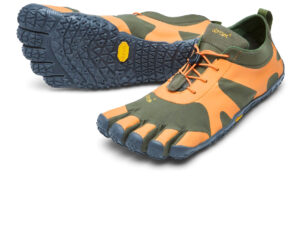Running has always been a part of my life in some way shape or form – firstly forced onto me in school, then eventually of my accord as I got older and could understand the benefits way more. The pounding of feet against the pavement, the rush of wind through my hair, and the sense of freedom that comes with each stride – it’s an experience like no other. IYKYK. Over the years, I’ve tried various types of running shoes, from cushioned to minimalist, each promising a unique advantage. However, nothing intrigued me quite like the concept of running in barefoot shoes. The idea of reconnecting with the earth, mimicking the natural movement of our ancestors, and potentially reducing injuries all appealed to me. So, with a blend of curiosity and skepticism, I embarked on a journey to explore whether running in barefoot shoes is a viable and beneficial option. Follow me while I take you through it 🙂
The Barefoot Revolution
The concept of running barefoot or in minimalist shoes has gained considerable attention in recent years. Proponents argue that the human foot is perfectly designed for running, and that modern, heavily cushioned shoes have led to poor biomechanics and an increased risk of injuries. No thanks! The idea behind barefoot shoes is to provide minimal protection while allowing the foot’s natural mechanics to shine. The appeal is undeniable: it’s a way to reconnect with our primal roots – I am woman, hear me roar! – and experience the world underfoot in a way that traditional shoes might obscure.
Choosing the Right Barefoot Shoes
As I delved into this experiment, the first step was to find the right pair of barefoot shoes. It’s important to note that not all minimalist shoes are created equal. Some offer thin soles with little more than a layer of rubber, while others have a bit more cushioning and protection. After thorough research and several visits to specialty stores, I settled on a pair that struck a balance between minimalism and comfort. We are all different so a bit of trial and error is totes normal.
One of the key aspects to consider when selecting barefoot shoes is the level of support they offer. I opted for a pair that had a thin, flexible sole to allow for a natural range of motion while still providing enough protection against sharp objects and rough terrain. The fit was snug but not constricting, allowing my toes to spread and grip the ground as they naturally would. Feeling at one with nature- ya know?
Transitioning to Barefoot Shoes
Transitioning to barefoot shoes from traditional running shoes isn’t an overnight process. Our feet and legs have adapted to the cushioning and support of modern shoes, so it’s crucial to introduce the new style gradually to avoid overuse injuries. Patience is a virtue! I began by wearing my barefoot shoes for short walks and easy runs, gradually increasing the distance and intensity as my muscles and tendons adjusted to the new mechanics. Slow and steady wins the race (excuse the pun).
During this transition phase, I noticed a heightened awareness of my stride and foot placement. Without the cushioning and support of traditional shoes, my body instinctively adjusted to a more efficient running form. I was landing on the balls of my feet rather than the heels, which is a common hallmark of barefoot running. This shift in mechanics felt surprisingly natural and empowering. It’s fun to take notice and even record the changes and the benefits you’re feeling along the way.
Experiencing the Terrain
Running in barefoot shoes allowed me to truly experience the terrain beneath my feet. Every pebble, crack, and change in surface became noticeable as I ran. Initially, I approached uneven surfaces with caution, worried about discomfort or injury. However, over time, my feet became more adept at adapting to different textures, and the muscles in my feet and lower legs grew stronger, providing a newfound sense of stability. It was crazy!
One of the most profound aspects of running in barefoot shoes was the feeling of connection with the earth. I could feel the ground beneath me with each step, fostering a sense of being grounded and present in the moment. It was as if I was experiencing running in a more raw and unfiltered way, stripped of the barriers that traditional shoes create. I know I sound a bit hippy dippy but it was truly a revelation.
Challenges and Benefits
Running in barefoot shoes came with its own set of challenges and benefits. On the downside, the initial transition period required patience and careful monitoring to prevent overuse injuries. Yawn! There were moments when my calves felt tighter than usual, and I had to remind myself to take it easy and give my body time to adapt. It was also important to choose my running routes wisely, as some terrains were more forgiving than others. Let me say, it’s a process.
However, the benefits were remarkable. My stride felt more natural and efficient, and I noticed a reduction in the impact on my joints. Over time, I became more attuned to my body’s signals and cues, allowing me to make adjustments in real-time to prevent discomfort or strain. The strengthened muscles in my feet and lower legs provided enhanced stability, which translated not only to better running form but also to improved balance in everyday activities. It’s like applying a strain of mindfulness to running that I hadn’t before.
I’ll stop ranting now but I hope some insight has helped you on your own personal voyage. My exploration into running in barefoot shoes was an eye-opening journey that challenged my preconceived notions of running footwear. While the transition required patience and a willingness to adapt, the rewards were well worth the effort. Running in barefoot shoes allowed me to reconnect with the primal joy of running while fostering a sense of mindfulness and appreciation for the world underfoot. The experience emphasized the importance of embracing our body’s natural mechanics and the benefits of a more minimalist approach to running footwear. It’s such a vibe.
As with any running shoe choice, it’s important to remember that what works for one person might not work for another. Individual preferences, body mechanics, and running goals should all play a role in the decision-making process. If you’re considering making the switch to barefoot shoes, I encourage you to approach it with an open mind and a gradual transition. Embrace the opportunity to reconnect with the earth beneath your feet, and you might just discover a whole new dimension of running that you never knew existed. Once you do find your perfect barefoot running shoe, remember to share the love! You could be helping a fellow barefooter along the way.









